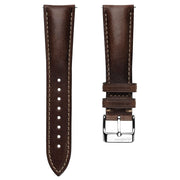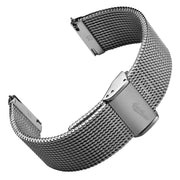There are many great rivalries in this world—Coke vs. Pepsi, Beatles vs. Stones, New York bagels vs. literally anything else. But in the watch world, one of the most entertaining divides is the quiet culture clash between American and European collectors. Sure, we all love a well-finished movement and a nicely domed crystal, but how we approach watches—and why we wear them—can vary wildly depending on which side of the Atlantic you're standing on.
So, we thought we’d settle it the best way we know how: passive-aggressively. With words. In neat little sections.
We’ll be tackling the big themes: design, heritage, mindset—and probably insulting each other’s straps along the way. It’s all in good fun. Mostly.
The Transatlantic Watch Collecting Debate
Style and Design Philosophy
Toolish and Bold (American) vs. Understated and Refined (European)?
Chris begins…
Let’s not dance around it—American watch taste is loud. We want watches that can survive a helicopter crash and still have enough wrist presence to double as a dinner plate. Toolish? Absolutely. Overbuilt? Proudly. Tasteful? Debatable. But there’s a kind of freedom in that. We're not afraid to wear something that looks like it could punch back. Show me a 38mm time-only dress watch and I’ll show you a nation full of people wondering where the rest of it went.
Rolex didn’t make the 44mm Deepsea in solid gold for Europe. That’s an American special—luxury built like a linebacker. We want our watches big, bold, and preferably capable of outliving us in a submarine implosion with our closest friends (even if we’re just going to Costco). Nuance? That’s for wine lists and diplomatic crises. If our watches are a reflection of our national personality, then yes—they should probably scream a little, cast a shadow, and leave a dent in the drywall when you take them off. Subtlety is fine… for Europeans. We like our wrists like we like our foreign policy: impossible to ignore.

Anna’s rebuttal…
Chris, while you’re busy strapping a dinner plate to your wrist and calling it a watch, we Europeans are quietly adjusting our cuffs over something a tad more…proportional. You say 38mm is incomplete? We call it elegant. In fact, show me a 44mm wrist-clock hulking under a suit and I’ll show you a European wondering which cathedral that bell tower fell off of.
American watches seem to prepare you for helicopter crashes or bear fights in the produce aisle. Look, we get the appeal of robust tool watches – Europe birthed plenty of them – but there’s a fine line between bold and brash. Yes, the original Panerai for Italian naval divers was a chunky 47mm, but that was military equipment. Meanwhile, we’re over here sipping espresso with a 36mm Longines that doesn’t bully our outfit. It’s not that we don’t like robust watches—we just prefer them not to look like they could take out a small drone.
You wear watches like you approach portion sizes. Big, bold, unapologetic. We’re more into the finesse: German Bauhaus minimalism, Swiss symmetry, and dress watches that actually fit under a cuff. In short, you’re swinging for the fences, and we’re quietly hitting precision shots down the line. And we’re fine with that. Quiet confidence ages better than tactical cosplay.
Heritage and Brand Attachment
Long-standing legacy brands (European) vs. bold indie newcomers (American)
Chris returns, proudly unburdened by centuries of watchmaking tradition…
Let’s be honest—when it comes to legacy, America’s watch industry is a little… haunted. Our old giants were either vaporized by the Quartz Crisis or absorbed into multinational empires headquartered somewhere with better cheese (shh, don’t tell Wisconsin). But don’t mistake that for weakness. It just means we’ve had room to reinvent—and nobody reinvents like America. We’ve traded dusty prestige for bold personality, and frankly, we’re thriving in it.
Take SēL Instruments, the first American manufacturer to build an all grade 5 titanium 6,000 meter diver—so over-engineered that Tony Stark would be jealous (Mickey Mouse, please don’t sue me). Or Brew Watches, a modern indie darling crafting metropolitan masterpieces for espresso-pulling, caffeinated weirdos like myself who prefer a vintage-inspired chrono over another delicate teacup of horological pretentiousness. Our brands may be younger, but they’re hungrier—and not weighed down by centuries of tradition, restraint, or monarchic guilt, even if we may be headed there!
European legacy is cute. But American indie is loud, sparkly, and shockingly well-built. We may not have your dusty archives, but we’ve got watches that slap. And for a nation founded by people who threw tea in a harbor, that feels about right.

Anna’s rebuttal
When it comes to horological legacy, let’s just say we were already crafting timepieces when your ancestors were still arguing over the best way to make tea. European brands like Vacheron Constantin, Blancpain, and Breguet weren’t just early to the party—we built the ballroom. We’re proudly weighed down by tradition, thank you very much. Those dusty archives you scoff at? We call them national treasures. While America’s old watch giants became ghosts of the Quartz Crisis, ours survived, adapted, and continued to handcraft tiny miracles.
So yes, European legacy isn’t just “cute” – it’s the bedrock of horology. We built the cathedral first; you guys are just adding some shiny new gargoyles on the roof.
American indies are exciting, and we appreciate the creativity, but let’s not pretend they are keeping Lange & Söhne up at night. At the end of the day, we’ll happily acknowledge your indie renaissance – it brings fresh ideas, and yes, some of your new makers are killing it. But a little respect for your elders, please.
We’ve got family-owned Swiss maisons and illustrious Glasshütte ateliers that have survived more drama than a soap opera. Legacy is our comfort zone. We form attachments to brands that grandpa and great-grandma cherished. A Jaeger-LeCoultre Reverso handed down through generations carries more emotional weight than any shiny new microbrand flavor of the month.

Mindset
Wearing to impress (American) or wearing to express (European)?
Chris, speaking directly from the land of Rolex and Red Meat
Look, America may be the land of opportunity, but let’s not pretend we’re taking turns. We race past each other with the pedal down, middle finger up, and when we hit the finish line, we celebrate the only way we know how—by buying something shiny and expensive enough to make our coworkers uncomfortable. We don’t just wear watches to impress—we wear them to dominate.
Sure, most of those shiny things are Swiss. But that’s only because we recognize excellence when we see it—and then immediately try to one-up it with a solid gold bezel and a shouty wrist shot. Still, come the weekend, when the flexing calms down and we’re poolside with a Coors and a questionable tan, we return to our roots. We bust out the chonky, overbuilt, gloriously excessive tool watches—because even at our most casual, we want to look like we might be called into active duty at any moment. You know... just in case.
Self-expression is great. But we prefer a kind that also turns heads from across the Wal-Mart parking lot.

Anna’s rebuttal
You wear watches to impress. We wear them to express. That’s the difference. In Europe, flashing a two-tone gold chrono at the office might get you side-eyed, not applauded. We like our status symbols discreet—more “quiet luxury,” less “Las Vegas blackjack dealer.”
When we buy a watch, it’s not just about specs. It’s about a feeling, a connection. A story. Maybe it was bought to celebrate a graduation, or maybe it’s a vintage Omega we found in our grandfather’s drawer. Either way, it means something. We don't need strangers across the parking lot to notice. We only need to smile when we check the time.
You guys wear watches like you're on standby for a Navy SEAL call-up. We wear them for brunch in Florence. Not less important—just a different vibe.
The Final Verdict
And the winner is...
So, who wins? Honestly, no one—and everyone. Chris and I will probably never agree on case sizes or how much lume is too much. But we both love watches, and that’s what counts.
You bring the chaos, we bring the heritage. You go big, we go subtle. But at the end of the day, we’re all united by the same irrational love for these ticking little time machines. Whether it’s blasting wrist presence from 50 feet or quietly ticking under a linen sleeve, we’re all just trying to find the perfect watch that makes us smile.
And if nothing else, at least we’ve given each other something to argue about at the next meet-up. Which is, let’s face it, half the fun.










